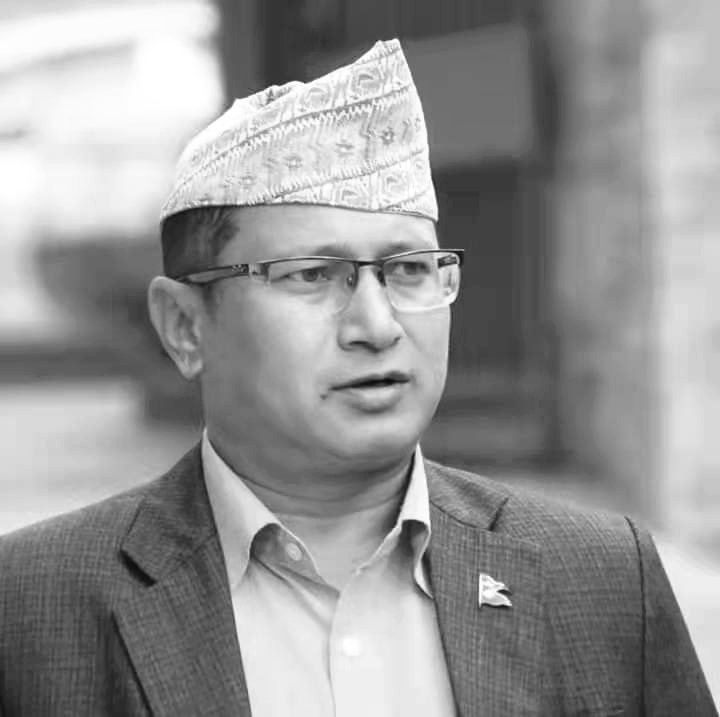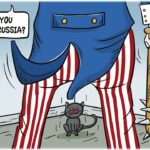# Prem Sagar Poudel
The activities of independent Tibetans are increasing in Nepal. With the increase in American activism due to the MCC, Tibetans in Nepal seem to be excited. Their activism in Nepal has started to increase due to the support of the Nepal government.
The following recent events show where Nepal is heading.
Tibetan refugees living in Kathmandu celebrate the Tibetan New Year (Lhosar). US Ambassador to Nepal Randy Berry, British Ambassador Nicola Polit, Swiss Ambassador Elizabeth Von Kepler and Australian Ambassador Felicity Volk were present on the occasion on 5 March at Jawlakhel, Kathmandu.
On March 4, members of the US Mission in Nepal, including US Ambassador to Nepal Randy Berry, Deputy Chief of Mission Micaller, demonstrated on behalf of the Ukrainian people. In front of the US embassy, they put up a banner in Nepali states, “We are with Ukraine.” In addition, since March 5, the US Mission in Nepal, in solidarity with Ukraine and the Ukrainian people has been painted in what appears to be the color of the Ukrainian national flag.
US Ambassador Randy Berry, Honorary Consul General to Ukraine Kiran Vaidya and United Kingdom, Norway, Finland, European Union, Australia, New Zealand, Switzerland, Germany, Japan, South Korea, Israel, the Director of ILO, as well as the Honorary Consul General of New Zealand and Latvia met on 3rd March in Bouddhanath Stupa against the attack on Ukraine. They sympathized with candlelight in memory of those killed in Ukraine over the past week. The program featured the Ukrainian national anthem, “Ukraine is not destroyed yet.” Various ambassadors read excerpts from speeches delivered by Ukrainian President Volodymyr Zelensky over the past seven days.
On March 2, US Secretary of State Anthony Blinken had a telephone conversation with Nepal’s Prime Minister Sher Bahadur Deuba. During the talks, the issue of Ukraine was discussed. Following the talks, Nepal voted in favor of Ukraine in the UN Human Rights Council. On March 3, meeting of the Council in Geneva, Ukraine’s ambassador to the United Nations proposed an emergency discussion of human rights in Ukraine following the Russian invasion. Russia, a member of the Council, has stated that such discussion is not necessary. The proposal was voted on after a dispute between the two sides. During the vote, Nepal voted in favor of discussing Ukraine’s proposal. India was absent from the polls. China voted against the Ukrainian proposal. On the same day that Russia invaded Ukraine, Nepal stated that Russia’s move was against the UN Charter.
The largest pro-independence Tibet movement since 2008 was attended by US Ambassador Randy Berry, British Ambassador Nicola Polit, Swiss Ambassador Elizabeth Von Kepler, and the Australian Ambassador. The ambassadors of China’s opposition countries are openly gathering inside Nepal, which is adhering to the one-China policy, and the visits of US and European ambassadors to Rara Lake, Chitwan and Eastern Nepal are going smoothly. While the Nepal government is in favor of the one-China policy, it has not yet sought any explanation as to why they have openly challenged the state policy. From this, it is clear that Nepal has officially gone against one-China-policy. In the days to come, it is clear that Nepal will be very uncomfortable, awkward and difficult for China.
With the US and Australian economic and other support, the Omkar Maha Abhiyan and the National Unity Campaign are preparing to form a military unit in the Terai of Nepal. From next April, Omkar Maha Abhiyan and National Unity Campaign will provide military training to Nepalese youth in various districts of Terai.
After the formation of this government, the issue of border dispute with China seems to have come up in the media continuously. Lately, there have been reports in the media of the intention to immediately remove the wire laid by China in the Kit Khola area of Humla. The wire is intended to stop the movement of independent Tibetans. With the removal of that wire, it will be easier for those to enter in Nepal who go to India’s Dharamsala from Tibet to meet the Dalai Lama. The Kitkhola dispute was brought to the fore during the search for a gateway for the Tibetans to do up-down.
Analyzing some of the above examples, it becomes clear where Nepal is going. While the MCC is being debated, the American influence in Nepal is growing. As a result, Maoist Chairman Pushpa Kamal Dahal and CPN (US) Chairman Madhav Kumar Nepal have come closer to the United States. Ambassador Berry, who has been in regular contact with them, is also becoming more active. In the midst of this activism, he began the task of uniting the independent Tibetans in Nepal. Organized within a few weeks of the start of this work, the Tibetans’ celebration of Lhosar has made them excited.
The United States has long had not much interest in the independent Tibet. In particular, during the Cold War, the United States did not need to take any action against China, which was at the poles of the United States. After the collapse of the Soviet Union, US attention again turned to the independent Tibetans who had been ignored in 1972. The United States has been supporting them since 1991. For now, the United States has felt like hunting tiger with a fox-hunting weapon. However, the United States will not abandon this issue easily as well.
Since the 2008 Olympics, there has been little movement of independent Tibetans in Nepal. However, their presence in Nepal is more than ever. Their activities have not been seen due to the programs organized within the camps and monasteries. They are camp-centric because of the government’s request not to engage in any activities other than the appeal of the Dalai Lama sheltering country.
In the meantime, the United States has been working closely with them. However, the extent to which the United States supports the refugee problem was unclear. They were unable to leave the camp because of the mistrust between the United States and the refugees. But now that has changed. Not only the United States, but also the United Kingdom, Switzerland, Australia and other western nations are united on the issue of Tibetan refugees. By participating in the program organized on the occasion of Lhosar for the last time, they have also given the message that they are together.
The US Senate passed the Tibet Policy and Support Act-2020 on December 28, 2020. After losing the election, President Donald Trump has called for such an act to be passed. The law, introduced by President Trump after failing in a trade war with China, has the power to impose sanctions on Chinese officials appointing a successor to the Dalai Lama, a Tibetan religious leader, who resides in India. After President Trump signed the law on December 28, it was decided to provide $ 6 million annually to Tibetan refugees living in India and Nepal from 2021 to 2025. The money will be spent on Tibetan culture, education, language and leadership development of the new generation.
Law and budget alone are not enough. The implementation of the plan is the most important issue. The United States is at this stage now. In the first phase, the United States pursued a policy of pressuring China to open the border between Nepal and China. Such a policy was used invisibly by the Government of Nepal. The US is interested in creating an environment of free movement for Tibetans who want to enter in Nepal. In addition, the United States wants to see a practical transformation of the amicable agreement not to return Tibetans to China, who come Nepal. Therefore, in the first phase of the program, the United States has succeeded that China has encroached the border of Nepal among Nepalese. The recent statements of the Government of Nepal on the border also make this clear.
The US interest seems to be more focused on allowing Tibetans in Nepal to move freely. In addition, they have been raising their voices saying that the government of Nepal has been interfering in the religious programs of Tibetans. In the first phase, Nepal seems to loose in the Tibetans’ programs and their movements. That signal has already been given by the Lhosar program. On the other hand, the question of why the ambassadors chose Bouddha to support Ukraine is also important. Swayambhu is more important than Bouddha in wishing for peace. However, there are more Tibetans living in the Bouddha area. While speaking in favor of Ukraine, they seem to be trying to instill hope in Tibetans as well.
While addressing the concerns of the first phase of the West, including the Americans, Nepal can understand that the process stop here. But, this is just the beginning. After the success of the first phase, they will increase the pressure to give cards to Tibetans. Nepal does not recognize refugees who entered Nepal after 1990. Therefore, they do not get any identity card from Nepal. The government estimates that there are 12,000 Tibetan refugees in Nepal, and campaigners say 20,000. In the second phase, US interest seems to be focused on raising the official figure from 12,000 to 20,000.
The United States has not done now only to institutionalize the Tibetan issue. According to their plan, the process gained momentum on November 21, 2020, when Lobsang Sange, chairman of the Central Tibetan Administration (CTA), was welcomed on the red carpet at the White House. This is the first time since the Tibetans left Tibet that the chief of CTA has entered in the White House. Since becoming CTA president in 2011, Sange has met with White House officials dozens of times. He was given a public welcome at the White House amid strained US-China relations. Heads of state and government of South Asian countries were invited to the swearing-in ceremony of Modi for the first time as Prime Minister in 2014. Sange was also given the status of head of government at the event. Both of these incidents illustrate how the Tibetan issue is being institutionalized.
Due to pressure from China, the Modi government could not carry out the activities of Tibetans in India as the US thought. In 2018, the Indian Ministry of External Affairs wrote a letter to top government officials and ruling parties ordering them not to participate in Tibetan activities. On the basis of the letter, the 60th anniversary of the exiled of Dalai Lama, which was being held in Delhi, was canceled. After that, the activities of the Tibetans became concentrated within the Dharamsala. The United States gradually shifted its focus to Nepal-centric activities, implying that the Indian government did not cooperate.
Tibetan refugees in Nepal, who have remained silent even during the annual Tibetan Uprising Day on March 10, became active after tensions rose on the border between India and China. Immediately after the clash between India and China in Ladakh, posters with the slogan ‘Independent Tibet’ were pasted on Kathmandu Pharping. A September 4, 2020 newsletter from the European Foundation for South Asian Studies stated that “continuing border tensions could create an environment for greater international support for an uprising against China in Tibet by Delhi.” It is claimed that the Dalai Lama could send a message to his followers in Tibet. This incident also shows how India can play the Tibetan card. At present, the activity of the West seems to have increased with the idea of increasing the activities of Tibetans in Nepal before India.
This time, there is a program to celebrate Tibet Day by waving the Tibetan flag from March 10 to 20. Tsewang Norbu was arrested on February 25 while trying to set himself on fire in front of the Potala Palace in Lhasa in support of an independent Tibetan state, Tibetans have been campaigning that the Chinese police tortured and killed him. It seems that the Americans have started a 10-days long program, including the March 12 Tibetan Women’s Movement Day. The program has started in Taiwan on the occasion of March 10. Details have been made public at events in various cities across the United States. The recent approach of the Nepalese government towards Tibetans is further clarified by the issue of how March 10 is celebrated in Nepal.




